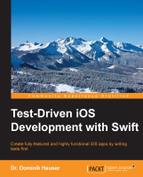In Chapter 6, Putting It All Together, we saw that unit tests could only test micro features in isolation. The next step would be to use integration tests to make sure that individual features play well together. In integration tests, you do not mock other components. Instead, you use the real implementation and write tests that make sure that the different parts of the code base interact with each other in the way you anticipated.
You can also use XCTest to implement integration tests. But the setup is more complicated than in the tests we have seen in this book. You use real classes and structs, and even network requests can fetch real data from a web service. What makes integration tests more complicated is that you don't want to change data in a real database during the test. This means that everything you do in the test has to be reverted when the test is finished. Or, you may have to use a different database or web service for the test.
The disadvantage of integration tests in respect to unit tests is that it is much harder to find the reason for a failing test. This means that integration tests are complementary to a unit test suite. Integration tests should only fail because of an error in the integration, not because one of the units has a bug. So, you should not skip writing unit tests.
